Research Proposal: Capital Budgeting in Petroleum Companies
VerifiedAdded on 2023/03/20
|13
|2221
|54
Project
AI Summary
This research proposal investigates the impact of crude oil price volatility on the capital budgeting practices of petroleum companies, with a specific focus on Aramco Saudi. The introduction highlights the importance of capital budgeting in maximizing shareholder wealth and addresses the challenges posed by fluctuating crude oil prices. The problem statement emphasizes the need to understand the effects of price volatility on Aramco's strategic decisions. The research objectives aim to determine the effect of crude oil price volatility on Aramco's budgets, identify the applied capital budgeting techniques, assess budgetary policies, and evaluate the effectiveness of these methods in achieving Aramco's 2020 Vision. The research questions explore the potential effects of volatility, the capital budgeting techniques used, project evaluation methods, and the effectiveness of current methods. The scope is limited to Aramco Saudi's practices over the past five years, with the anticipated contribution being a deeper understanding of capital budgeting techniques in crude oil-dependent economies. The proposal outlines feasible limitations, the thesis structure, and provides a summary of the chapter, along with references to relevant literature and research.
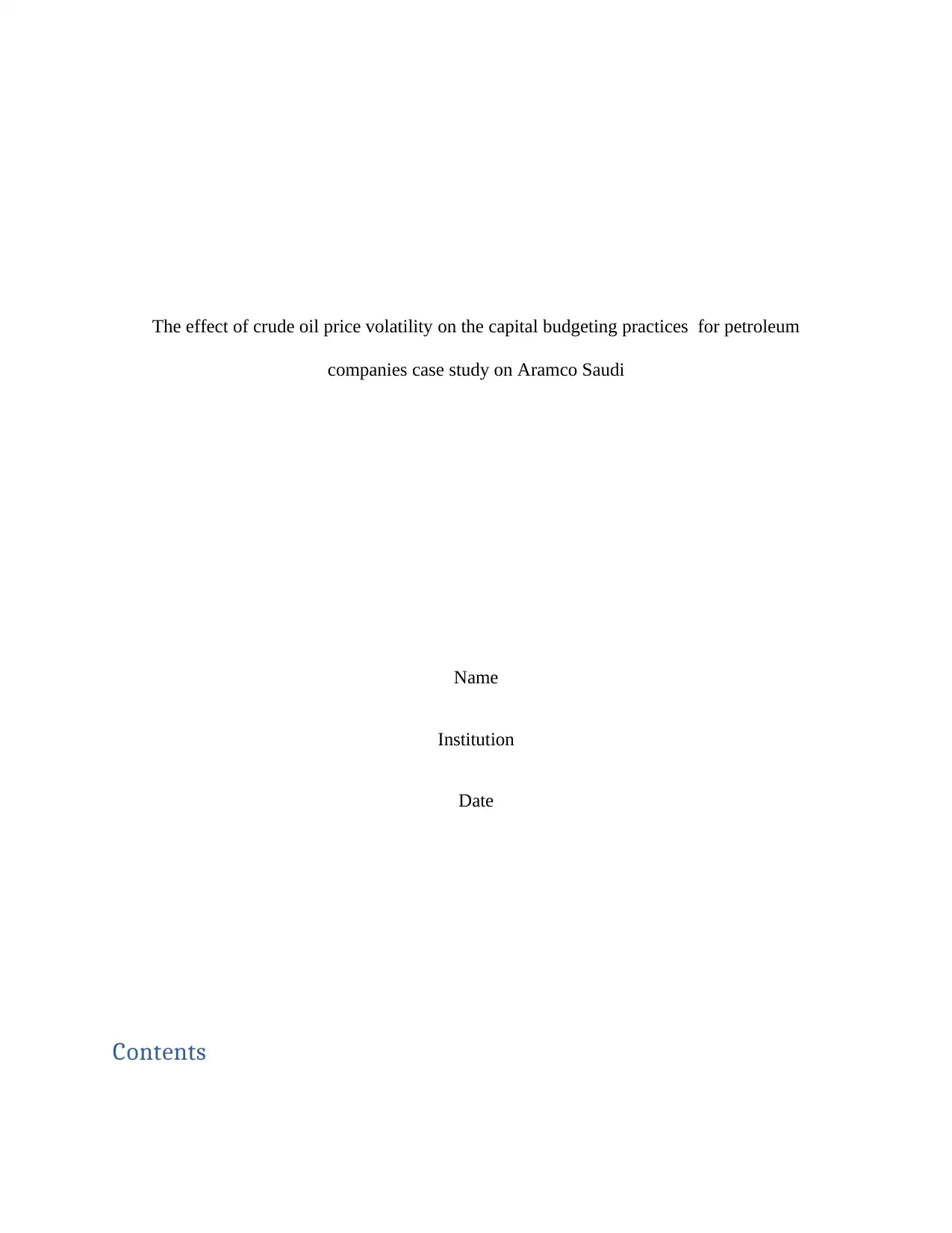
The effect of crude oil price volatility on the capital budgeting practices for petroleum
companies case study on Aramco Saudi
Name
Institution
Date
Contents
companies case study on Aramco Saudi
Name
Institution
Date
Contents
Paraphrase This Document
Need a fresh take? Get an instant paraphrase of this document with our AI Paraphraser
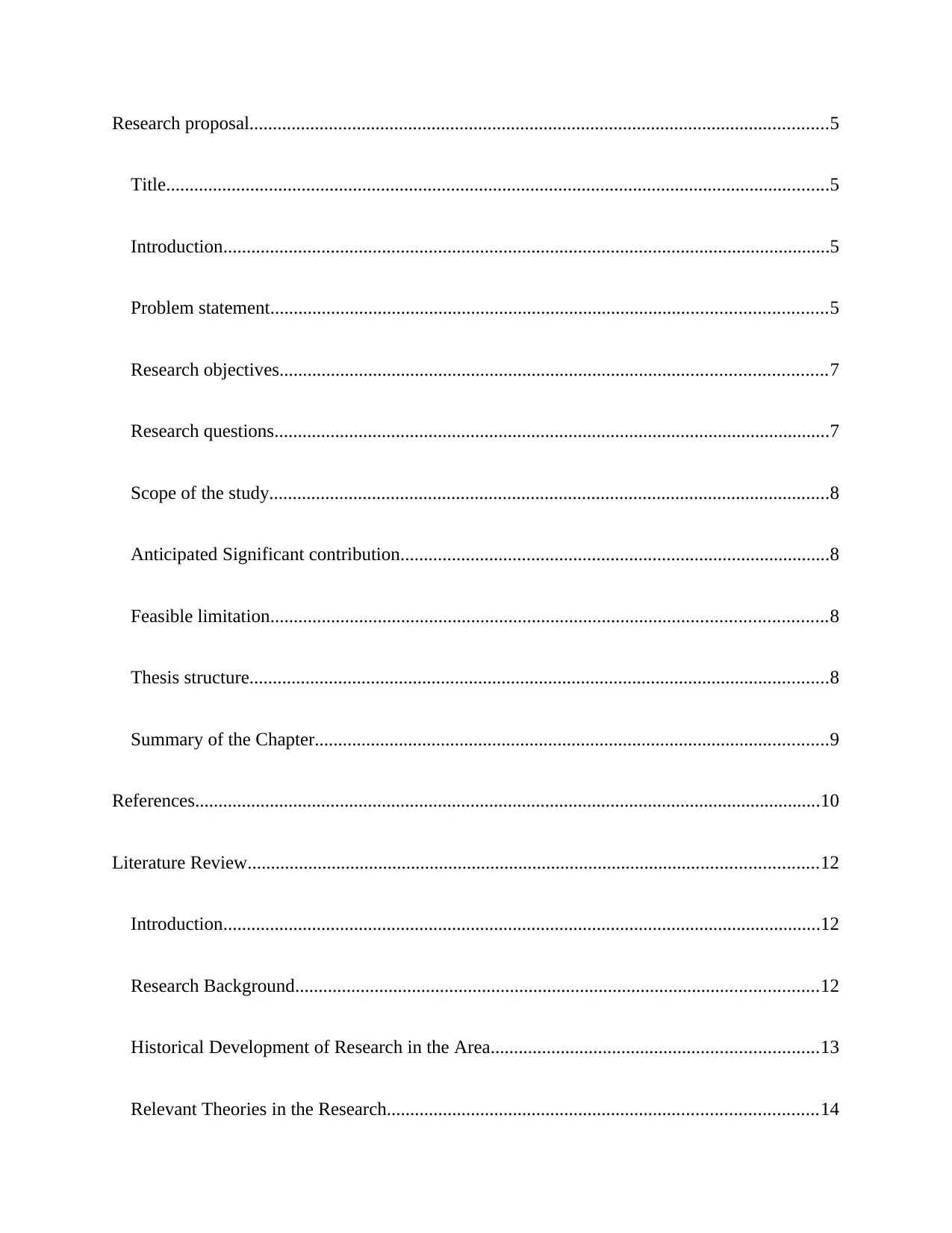
Research proposal............................................................................................................................5
Title..............................................................................................................................................5
Introduction..................................................................................................................................5
Problem statement.......................................................................................................................5
Research objectives.....................................................................................................................7
Research questions.......................................................................................................................7
Scope of the study........................................................................................................................8
Anticipated Significant contribution............................................................................................8
Feasible limitation.......................................................................................................................8
Thesis structure............................................................................................................................8
Summary of the Chapter..............................................................................................................9
References......................................................................................................................................10
Literature Review..........................................................................................................................12
Introduction................................................................................................................................12
Research Background................................................................................................................12
Historical Development of Research in the Area......................................................................13
Relevant Theories in the Research............................................................................................14
Title..............................................................................................................................................5
Introduction..................................................................................................................................5
Problem statement.......................................................................................................................5
Research objectives.....................................................................................................................7
Research questions.......................................................................................................................7
Scope of the study........................................................................................................................8
Anticipated Significant contribution............................................................................................8
Feasible limitation.......................................................................................................................8
Thesis structure............................................................................................................................8
Summary of the Chapter..............................................................................................................9
References......................................................................................................................................10
Literature Review..........................................................................................................................12
Introduction................................................................................................................................12
Research Background................................................................................................................12
Historical Development of Research in the Area......................................................................13
Relevant Theories in the Research............................................................................................14
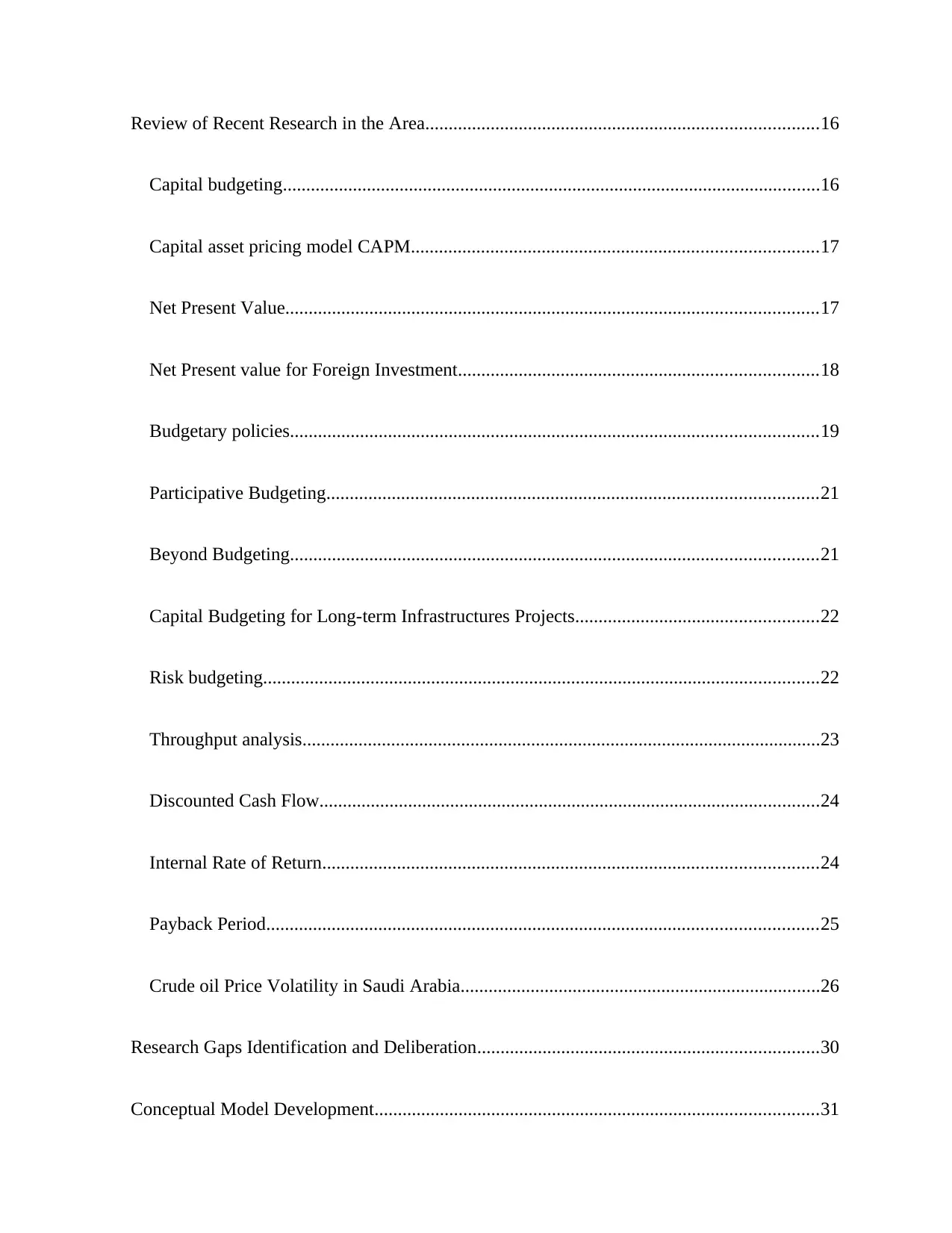
Review of Recent Research in the Area....................................................................................16
Capital budgeting...................................................................................................................16
Capital asset pricing model CAPM.......................................................................................17
Net Present Value..................................................................................................................17
Net Present value for Foreign Investment.............................................................................18
Budgetary policies.................................................................................................................19
Participative Budgeting.........................................................................................................21
Beyond Budgeting.................................................................................................................21
Capital Budgeting for Long-term Infrastructures Projects....................................................22
Risk budgeting.......................................................................................................................22
Throughput analysis...............................................................................................................23
Discounted Cash Flow...........................................................................................................24
Internal Rate of Return..........................................................................................................24
Payback Period......................................................................................................................25
Crude oil Price Volatility in Saudi Arabia.............................................................................26
Research Gaps Identification and Deliberation.........................................................................30
Conceptual Model Development...............................................................................................31
Capital budgeting...................................................................................................................16
Capital asset pricing model CAPM.......................................................................................17
Net Present Value..................................................................................................................17
Net Present value for Foreign Investment.............................................................................18
Budgetary policies.................................................................................................................19
Participative Budgeting.........................................................................................................21
Beyond Budgeting.................................................................................................................21
Capital Budgeting for Long-term Infrastructures Projects....................................................22
Risk budgeting.......................................................................................................................22
Throughput analysis...............................................................................................................23
Discounted Cash Flow...........................................................................................................24
Internal Rate of Return..........................................................................................................24
Payback Period......................................................................................................................25
Crude oil Price Volatility in Saudi Arabia.............................................................................26
Research Gaps Identification and Deliberation.........................................................................30
Conceptual Model Development...............................................................................................31
⊘ This is a preview!⊘
Do you want full access?
Subscribe today to unlock all pages.

Trusted by 1+ million students worldwide
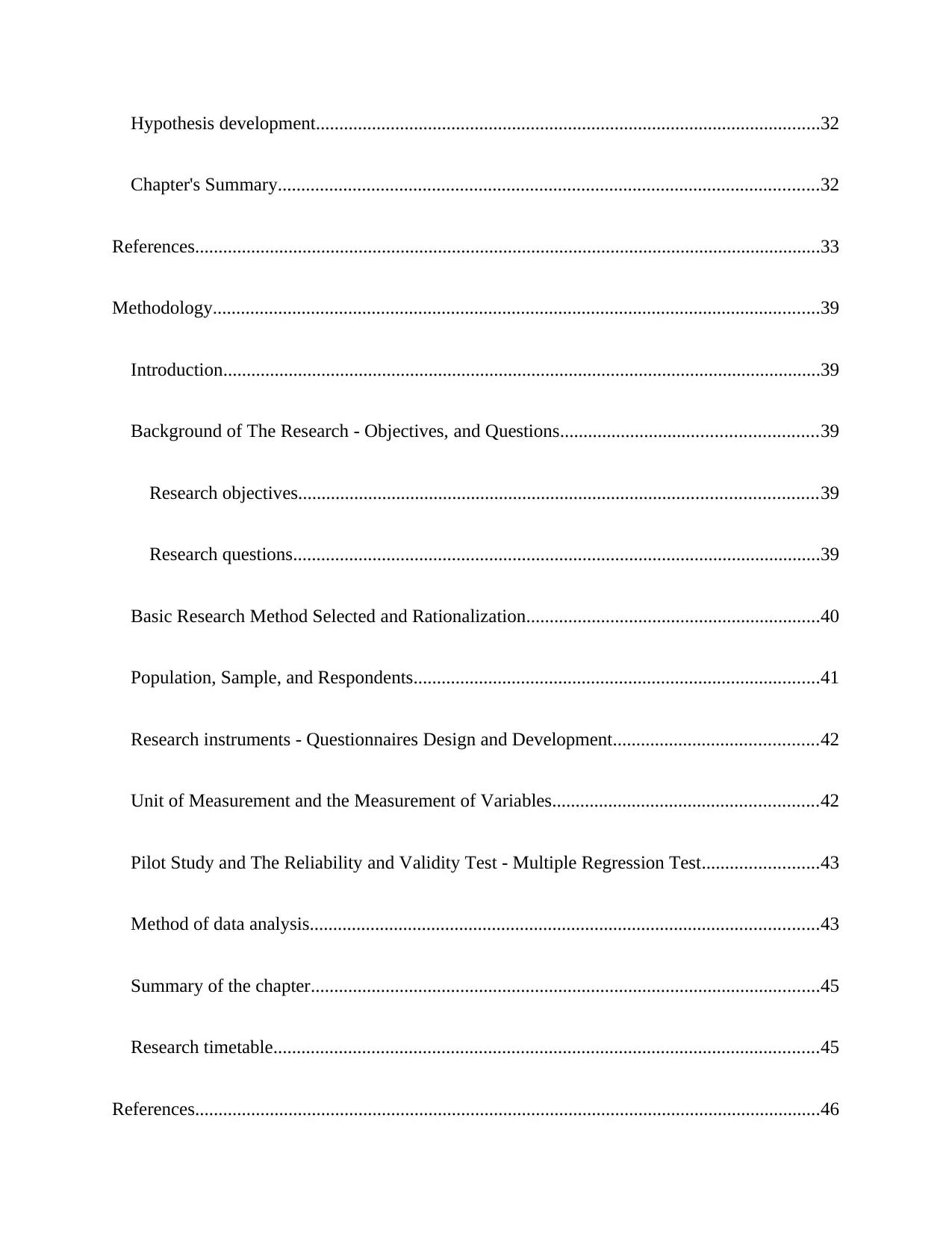
Hypothesis development............................................................................................................32
Chapter's Summary....................................................................................................................32
References......................................................................................................................................33
Methodology..................................................................................................................................39
Introduction................................................................................................................................39
Background of The Research - Objectives, and Questions.......................................................39
Research objectives...............................................................................................................39
Research questions.................................................................................................................39
Basic Research Method Selected and Rationalization...............................................................40
Population, Sample, and Respondents.......................................................................................41
Research instruments - Questionnaires Design and Development............................................42
Unit of Measurement and the Measurement of Variables.........................................................42
Pilot Study and The Reliability and Validity Test - Multiple Regression Test.........................43
Method of data analysis.............................................................................................................43
Summary of the chapter.............................................................................................................45
Research timetable.....................................................................................................................45
References......................................................................................................................................46
Chapter's Summary....................................................................................................................32
References......................................................................................................................................33
Methodology..................................................................................................................................39
Introduction................................................................................................................................39
Background of The Research - Objectives, and Questions.......................................................39
Research objectives...............................................................................................................39
Research questions.................................................................................................................39
Basic Research Method Selected and Rationalization...............................................................40
Population, Sample, and Respondents.......................................................................................41
Research instruments - Questionnaires Design and Development............................................42
Unit of Measurement and the Measurement of Variables.........................................................42
Pilot Study and The Reliability and Validity Test - Multiple Regression Test.........................43
Method of data analysis.............................................................................................................43
Summary of the chapter.............................................................................................................45
Research timetable.....................................................................................................................45
References......................................................................................................................................46
Paraphrase This Document
Need a fresh take? Get an instant paraphrase of this document with our AI Paraphraser
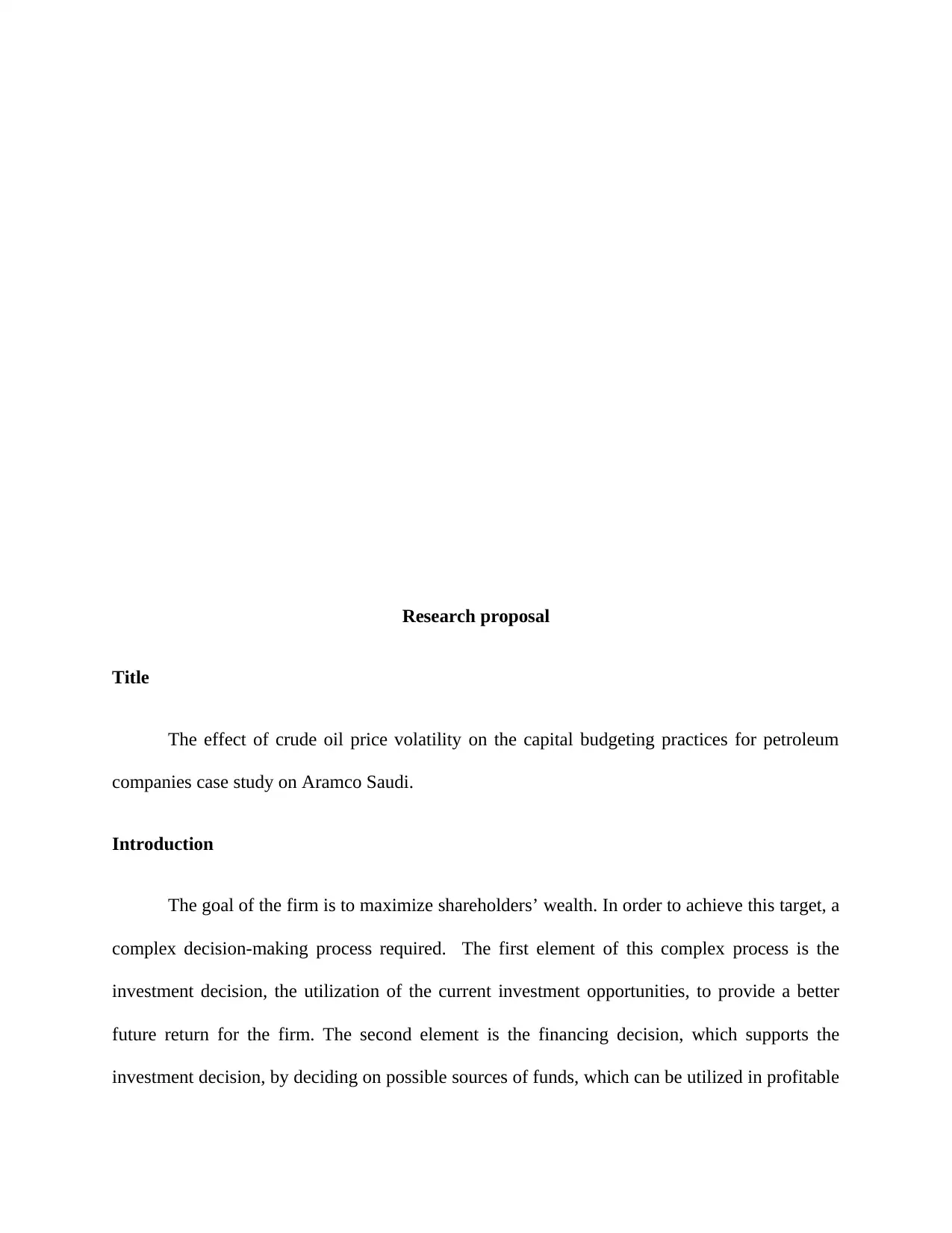
Research proposal
Title
The effect of crude oil price volatility on the capital budgeting practices for petroleum
companies case study on Aramco Saudi.
Introduction
The goal of the firm is to maximize shareholders’ wealth. In order to achieve this target, a
complex decision-making process required. The first element of this complex process is the
investment decision, the utilization of the current investment opportunities, to provide a better
future return for the firm. The second element is the financing decision, which supports the
investment decision, by deciding on possible sources of funds, which can be utilized in profitable
Title
The effect of crude oil price volatility on the capital budgeting practices for petroleum
companies case study on Aramco Saudi.
Introduction
The goal of the firm is to maximize shareholders’ wealth. In order to achieve this target, a
complex decision-making process required. The first element of this complex process is the
investment decision, the utilization of the current investment opportunities, to provide a better
future return for the firm. The second element is the financing decision, which supports the
investment decision, by deciding on possible sources of funds, which can be utilized in profitable
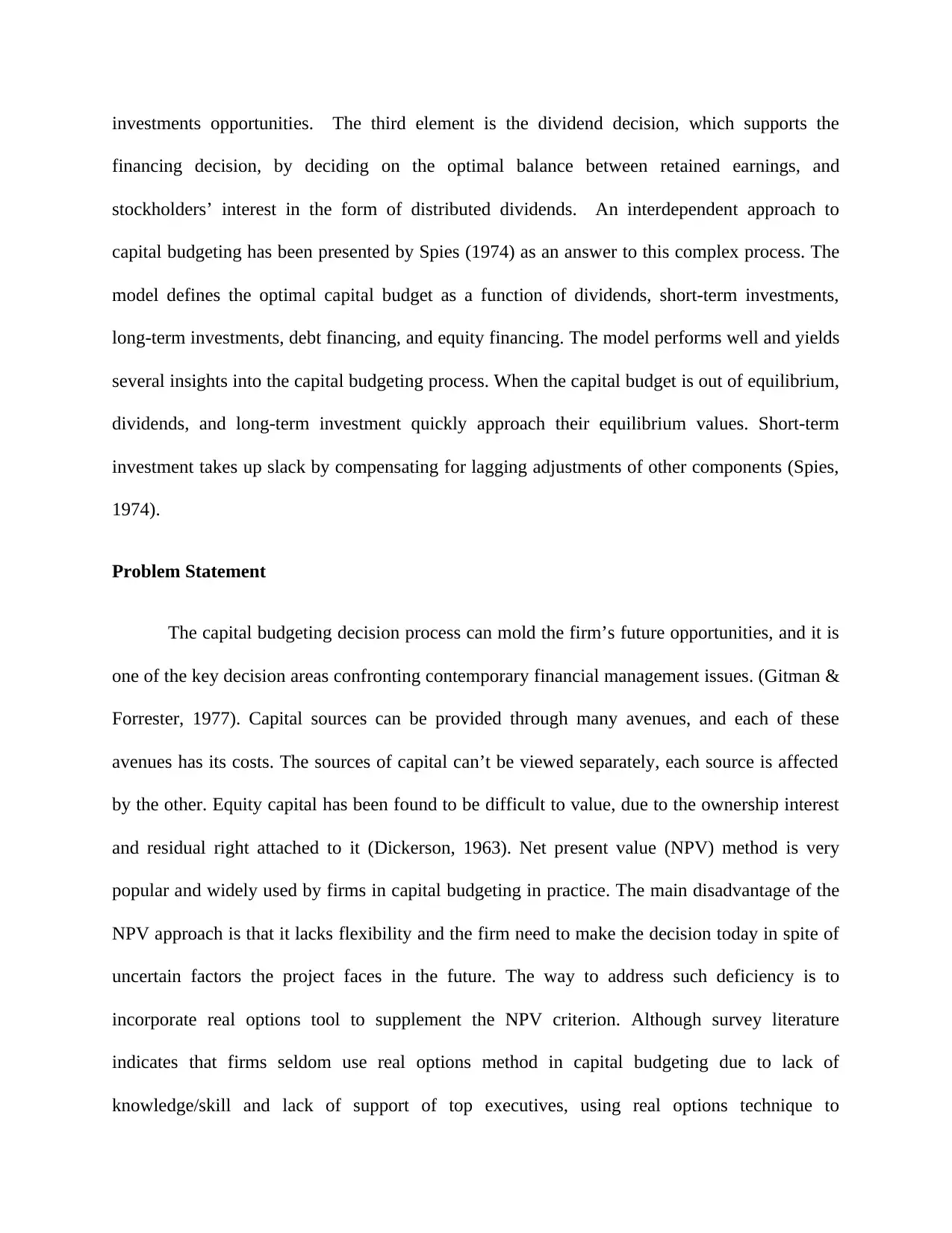
investments opportunities. The third element is the dividend decision, which supports the
financing decision, by deciding on the optimal balance between retained earnings, and
stockholders’ interest in the form of distributed dividends. An interdependent approach to
capital budgeting has been presented by Spies (1974) as an answer to this complex process. The
model defines the optimal capital budget as a function of dividends, short-term investments,
long-term investments, debt financing, and equity financing. The model performs well and yields
several insights into the capital budgeting process. When the capital budget is out of equilibrium,
dividends, and long-term investment quickly approach their equilibrium values. Short-term
investment takes up slack by compensating for lagging adjustments of other components (Spies,
1974).
Problem Statement
The capital budgeting decision process can mold the firm’s future opportunities, and it is
one of the key decision areas confronting contemporary financial management issues. (Gitman &
Forrester, 1977). Capital sources can be provided through many avenues, and each of these
avenues has its costs. The sources of capital can’t be viewed separately, each source is affected
by the other. Equity capital has been found to be difficult to value, due to the ownership interest
and residual right attached to it (Dickerson, 1963). Net present value (NPV) method is very
popular and widely used by firms in capital budgeting in practice. The main disadvantage of the
NPV approach is that it lacks flexibility and the firm need to make the decision today in spite of
uncertain factors the project faces in the future. The way to address such deficiency is to
incorporate real options tool to supplement the NPV criterion. Although survey literature
indicates that firms seldom use real options method in capital budgeting due to lack of
knowledge/skill and lack of support of top executives, using real options technique to
financing decision, by deciding on the optimal balance between retained earnings, and
stockholders’ interest in the form of distributed dividends. An interdependent approach to
capital budgeting has been presented by Spies (1974) as an answer to this complex process. The
model defines the optimal capital budget as a function of dividends, short-term investments,
long-term investments, debt financing, and equity financing. The model performs well and yields
several insights into the capital budgeting process. When the capital budget is out of equilibrium,
dividends, and long-term investment quickly approach their equilibrium values. Short-term
investment takes up slack by compensating for lagging adjustments of other components (Spies,
1974).
Problem Statement
The capital budgeting decision process can mold the firm’s future opportunities, and it is
one of the key decision areas confronting contemporary financial management issues. (Gitman &
Forrester, 1977). Capital sources can be provided through many avenues, and each of these
avenues has its costs. The sources of capital can’t be viewed separately, each source is affected
by the other. Equity capital has been found to be difficult to value, due to the ownership interest
and residual right attached to it (Dickerson, 1963). Net present value (NPV) method is very
popular and widely used by firms in capital budgeting in practice. The main disadvantage of the
NPV approach is that it lacks flexibility and the firm need to make the decision today in spite of
uncertain factors the project faces in the future. The way to address such deficiency is to
incorporate real options tool to supplement the NPV criterion. Although survey literature
indicates that firms seldom use real options method in capital budgeting due to lack of
knowledge/skill and lack of support of top executives, using real options technique to
⊘ This is a preview!⊘
Do you want full access?
Subscribe today to unlock all pages.

Trusted by 1+ million students worldwide
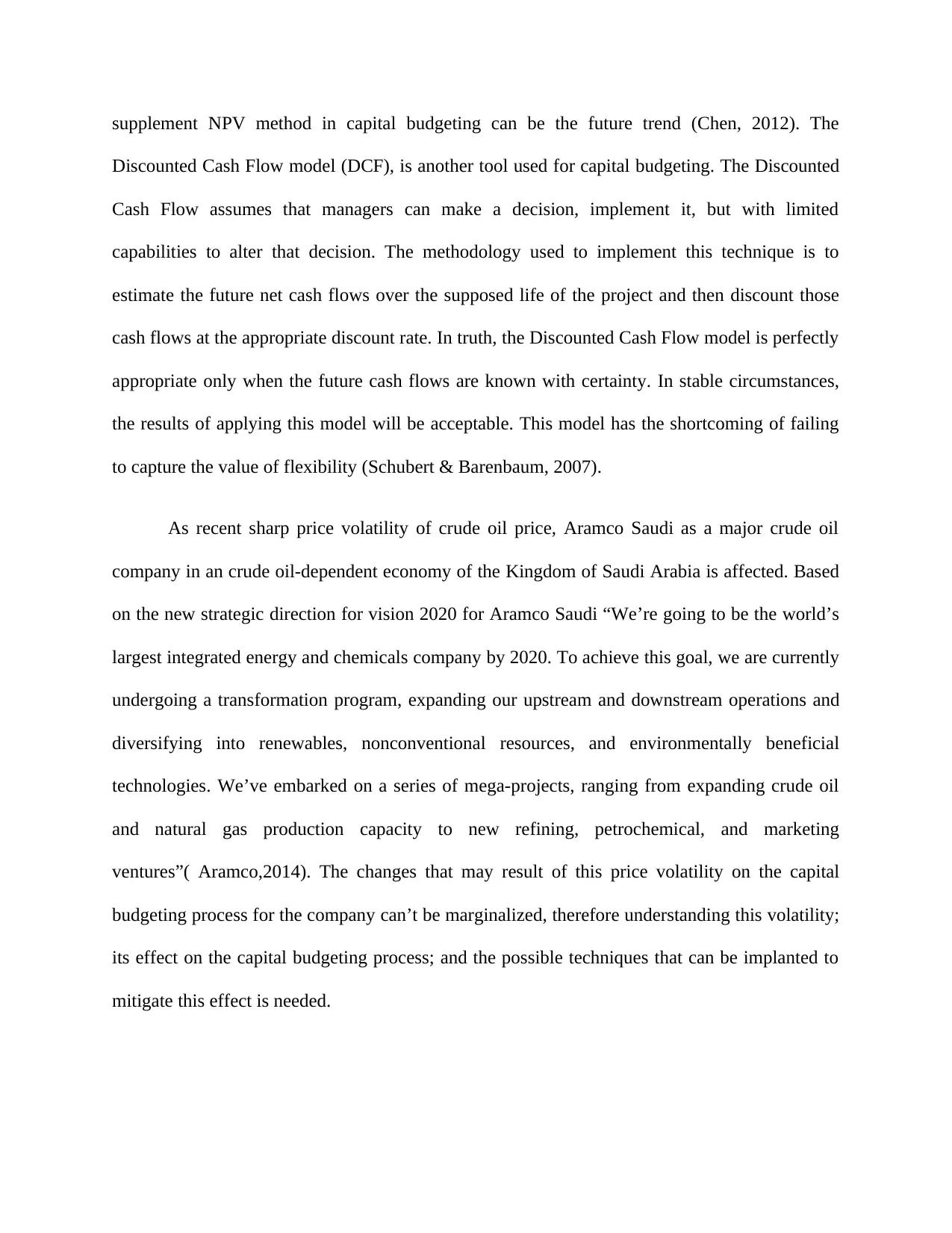
supplement NPV method in capital budgeting can be the future trend (Chen, 2012). The
Discounted Cash Flow model (DCF), is another tool used for capital budgeting. The Discounted
Cash Flow assumes that managers can make a decision, implement it, but with limited
capabilities to alter that decision. The methodology used to implement this technique is to
estimate the future net cash flows over the supposed life of the project and then discount those
cash flows at the appropriate discount rate. In truth, the Discounted Cash Flow model is perfectly
appropriate only when the future cash flows are known with certainty. In stable circumstances,
the results of applying this model will be acceptable. This model has the shortcoming of failing
to capture the value of flexibility (Schubert & Barenbaum, 2007).
As recent sharp price volatility of crude oil price, Aramco Saudi as a major crude oil
company in an crude oil-dependent economy of the Kingdom of Saudi Arabia is affected. Based
on the new strategic direction for vision 2020 for Aramco Saudi “We’re going to be the world’s
largest integrated energy and chemicals company by 2020. To achieve this goal, we are currently
undergoing a transformation program, expanding our upstream and downstream operations and
diversifying into renewables, nonconventional resources, and environmentally beneficial
technologies. We’ve embarked on a series of mega-projects, ranging from expanding crude oil
and natural gas production capacity to new refining, petrochemical, and marketing
ventures”( Aramco,2014). The changes that may result of this price volatility on the capital
budgeting process for the company can’t be marginalized, therefore understanding this volatility;
its effect on the capital budgeting process; and the possible techniques that can be implanted to
mitigate this effect is needed.
Discounted Cash Flow model (DCF), is another tool used for capital budgeting. The Discounted
Cash Flow assumes that managers can make a decision, implement it, but with limited
capabilities to alter that decision. The methodology used to implement this technique is to
estimate the future net cash flows over the supposed life of the project and then discount those
cash flows at the appropriate discount rate. In truth, the Discounted Cash Flow model is perfectly
appropriate only when the future cash flows are known with certainty. In stable circumstances,
the results of applying this model will be acceptable. This model has the shortcoming of failing
to capture the value of flexibility (Schubert & Barenbaum, 2007).
As recent sharp price volatility of crude oil price, Aramco Saudi as a major crude oil
company in an crude oil-dependent economy of the Kingdom of Saudi Arabia is affected. Based
on the new strategic direction for vision 2020 for Aramco Saudi “We’re going to be the world’s
largest integrated energy and chemicals company by 2020. To achieve this goal, we are currently
undergoing a transformation program, expanding our upstream and downstream operations and
diversifying into renewables, nonconventional resources, and environmentally beneficial
technologies. We’ve embarked on a series of mega-projects, ranging from expanding crude oil
and natural gas production capacity to new refining, petrochemical, and marketing
ventures”( Aramco,2014). The changes that may result of this price volatility on the capital
budgeting process for the company can’t be marginalized, therefore understanding this volatility;
its effect on the capital budgeting process; and the possible techniques that can be implanted to
mitigate this effect is needed.
Paraphrase This Document
Need a fresh take? Get an instant paraphrase of this document with our AI Paraphraser
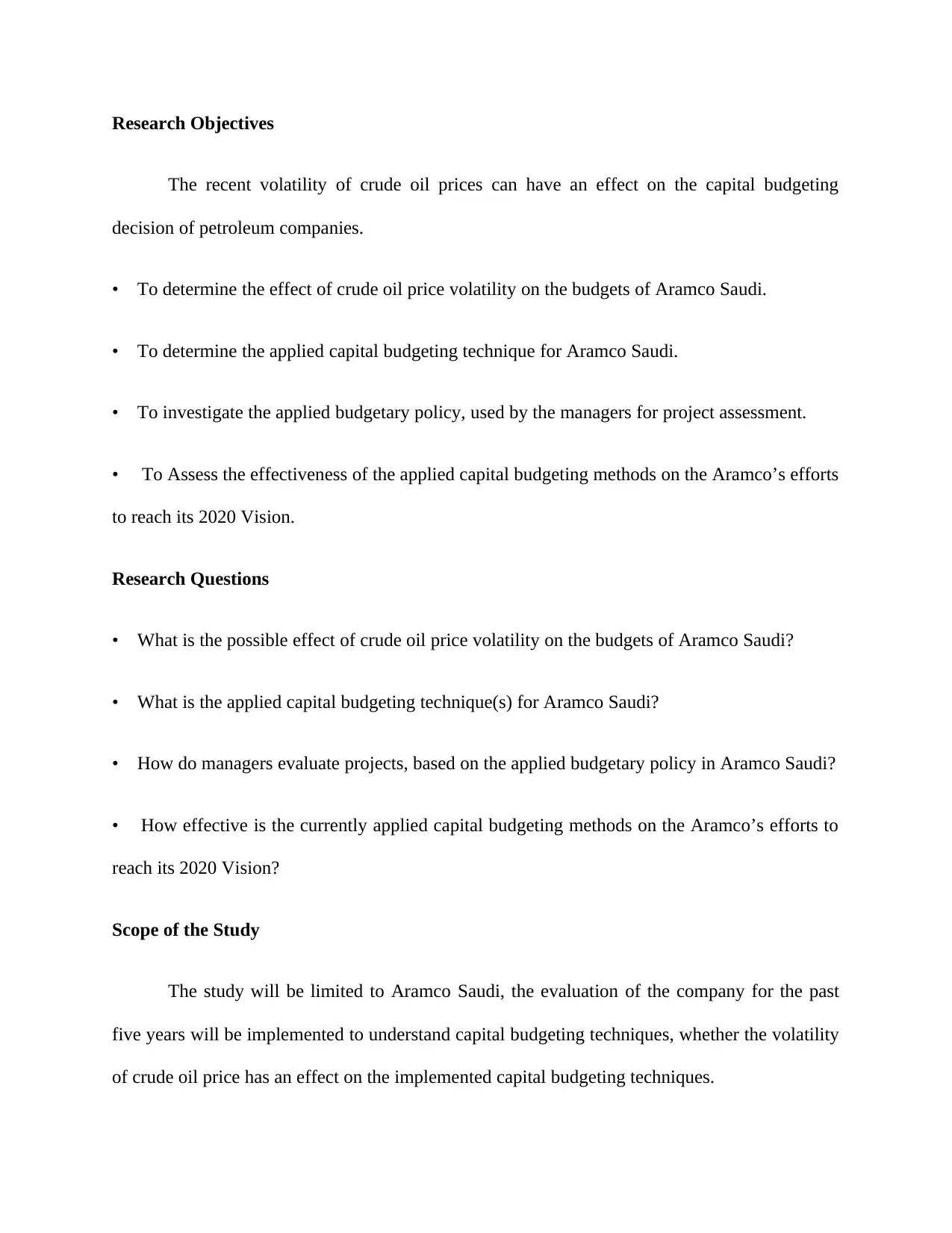
Research Objectives
The recent volatility of crude oil prices can have an effect on the capital budgeting
decision of petroleum companies.
• To determine the effect of crude oil price volatility on the budgets of Aramco Saudi.
• To determine the applied capital budgeting technique for Aramco Saudi.
• To investigate the applied budgetary policy, used by the managers for project assessment.
• To Assess the effectiveness of the applied capital budgeting methods on the Aramco’s efforts
to reach its 2020 Vision.
Research Questions
• What is the possible effect of crude oil price volatility on the budgets of Aramco Saudi?
• What is the applied capital budgeting technique(s) for Aramco Saudi?
• How do managers evaluate projects, based on the applied budgetary policy in Aramco Saudi?
• How effective is the currently applied capital budgeting methods on the Aramco’s efforts to
reach its 2020 Vision?
Scope of the Study
The study will be limited to Aramco Saudi, the evaluation of the company for the past
five years will be implemented to understand capital budgeting techniques, whether the volatility
of crude oil price has an effect on the implemented capital budgeting techniques.
The recent volatility of crude oil prices can have an effect on the capital budgeting
decision of petroleum companies.
• To determine the effect of crude oil price volatility on the budgets of Aramco Saudi.
• To determine the applied capital budgeting technique for Aramco Saudi.
• To investigate the applied budgetary policy, used by the managers for project assessment.
• To Assess the effectiveness of the applied capital budgeting methods on the Aramco’s efforts
to reach its 2020 Vision.
Research Questions
• What is the possible effect of crude oil price volatility on the budgets of Aramco Saudi?
• What is the applied capital budgeting technique(s) for Aramco Saudi?
• How do managers evaluate projects, based on the applied budgetary policy in Aramco Saudi?
• How effective is the currently applied capital budgeting methods on the Aramco’s efforts to
reach its 2020 Vision?
Scope of the Study
The study will be limited to Aramco Saudi, the evaluation of the company for the past
five years will be implemented to understand capital budgeting techniques, whether the volatility
of crude oil price has an effect on the implemented capital budgeting techniques.
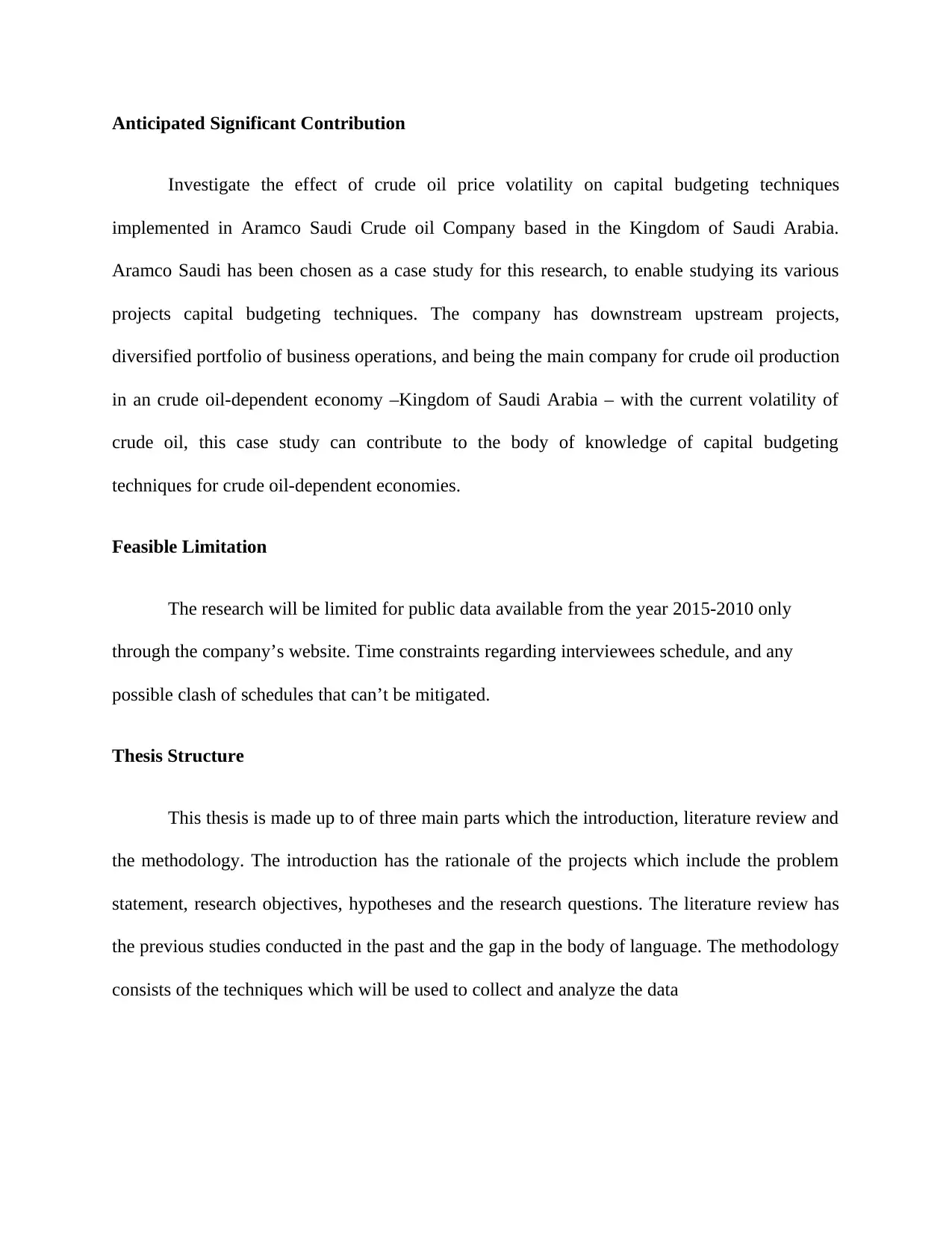
Anticipated Significant Contribution
Investigate the effect of crude oil price volatility on capital budgeting techniques
implemented in Aramco Saudi Crude oil Company based in the Kingdom of Saudi Arabia.
Aramco Saudi has been chosen as a case study for this research, to enable studying its various
projects capital budgeting techniques. The company has downstream upstream projects,
diversified portfolio of business operations, and being the main company for crude oil production
in an crude oil-dependent economy –Kingdom of Saudi Arabia – with the current volatility of
crude oil, this case study can contribute to the body of knowledge of capital budgeting
techniques for crude oil-dependent economies.
Feasible Limitation
The research will be limited for public data available from the year 2015-2010 only
through the company’s website. Time constraints regarding interviewees schedule, and any
possible clash of schedules that can’t be mitigated.
Thesis Structure
This thesis is made up to of three main parts which the introduction, literature review and
the methodology. The introduction has the rationale of the projects which include the problem
statement, research objectives, hypotheses and the research questions. The literature review has
the previous studies conducted in the past and the gap in the body of language. The methodology
consists of the techniques which will be used to collect and analyze the data
Investigate the effect of crude oil price volatility on capital budgeting techniques
implemented in Aramco Saudi Crude oil Company based in the Kingdom of Saudi Arabia.
Aramco Saudi has been chosen as a case study for this research, to enable studying its various
projects capital budgeting techniques. The company has downstream upstream projects,
diversified portfolio of business operations, and being the main company for crude oil production
in an crude oil-dependent economy –Kingdom of Saudi Arabia – with the current volatility of
crude oil, this case study can contribute to the body of knowledge of capital budgeting
techniques for crude oil-dependent economies.
Feasible Limitation
The research will be limited for public data available from the year 2015-2010 only
through the company’s website. Time constraints regarding interviewees schedule, and any
possible clash of schedules that can’t be mitigated.
Thesis Structure
This thesis is made up to of three main parts which the introduction, literature review and
the methodology. The introduction has the rationale of the projects which include the problem
statement, research objectives, hypotheses and the research questions. The literature review has
the previous studies conducted in the past and the gap in the body of language. The methodology
consists of the techniques which will be used to collect and analyze the data
⊘ This is a preview!⊘
Do you want full access?
Subscribe today to unlock all pages.

Trusted by 1+ million students worldwide
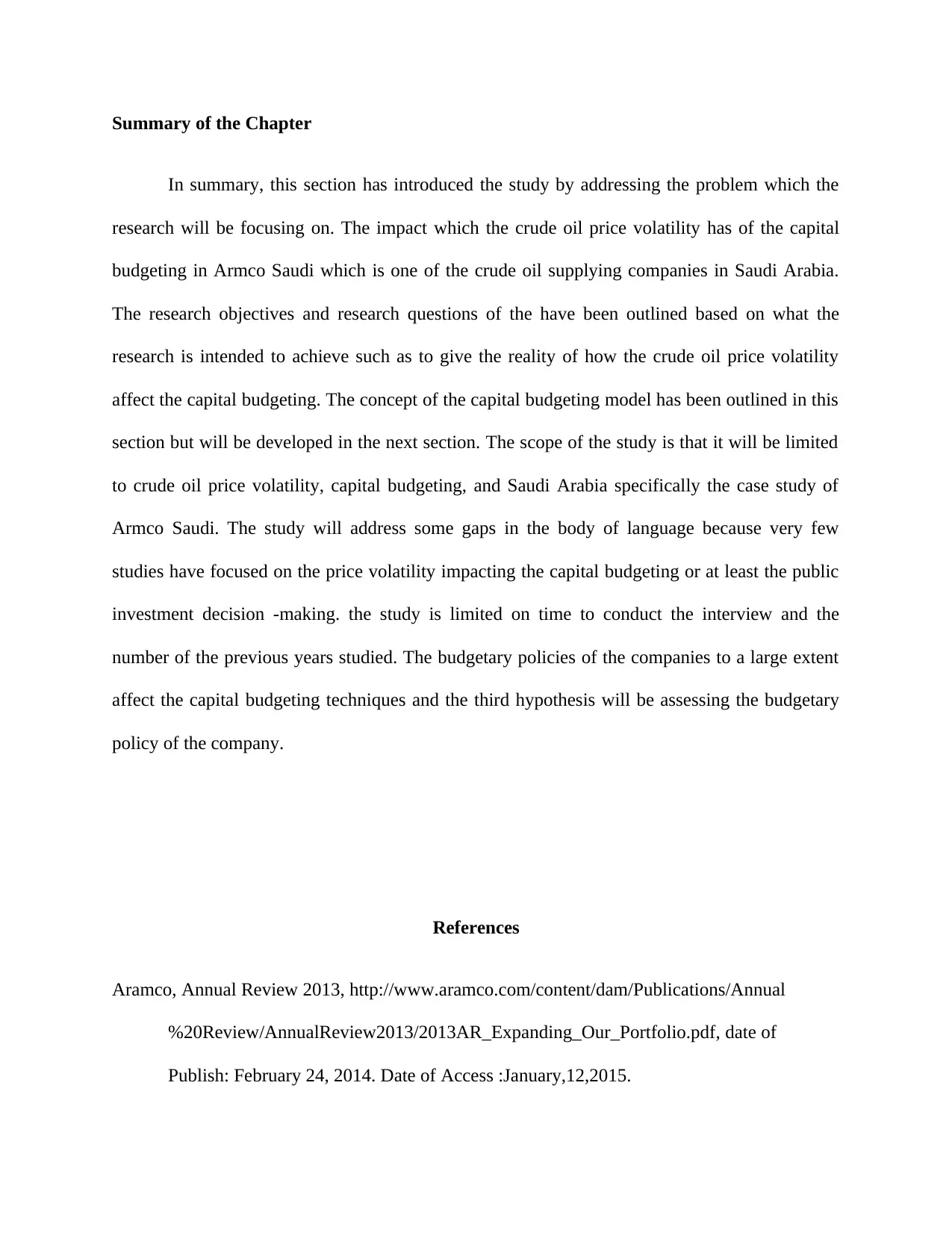
Summary of the Chapter
In summary, this section has introduced the study by addressing the problem which the
research will be focusing on. The impact which the crude oil price volatility has of the capital
budgeting in Armco Saudi which is one of the crude oil supplying companies in Saudi Arabia.
The research objectives and research questions of the have been outlined based on what the
research is intended to achieve such as to give the reality of how the crude oil price volatility
affect the capital budgeting. The concept of the capital budgeting model has been outlined in this
section but will be developed in the next section. The scope of the study is that it will be limited
to crude oil price volatility, capital budgeting, and Saudi Arabia specifically the case study of
Armco Saudi. The study will address some gaps in the body of language because very few
studies have focused on the price volatility impacting the capital budgeting or at least the public
investment decision -making. the study is limited on time to conduct the interview and the
number of the previous years studied. The budgetary policies of the companies to a large extent
affect the capital budgeting techniques and the third hypothesis will be assessing the budgetary
policy of the company.
References
Aramco, Annual Review 2013, http://www.aramco.com/content/dam/Publications/Annual
%20Review/AnnualReview2013/2013AR_Expanding_Our_Portfolio.pdf, date of
Publish: February 24, 2014. Date of Access :January,12,2015.
In summary, this section has introduced the study by addressing the problem which the
research will be focusing on. The impact which the crude oil price volatility has of the capital
budgeting in Armco Saudi which is one of the crude oil supplying companies in Saudi Arabia.
The research objectives and research questions of the have been outlined based on what the
research is intended to achieve such as to give the reality of how the crude oil price volatility
affect the capital budgeting. The concept of the capital budgeting model has been outlined in this
section but will be developed in the next section. The scope of the study is that it will be limited
to crude oil price volatility, capital budgeting, and Saudi Arabia specifically the case study of
Armco Saudi. The study will address some gaps in the body of language because very few
studies have focused on the price volatility impacting the capital budgeting or at least the public
investment decision -making. the study is limited on time to conduct the interview and the
number of the previous years studied. The budgetary policies of the companies to a large extent
affect the capital budgeting techniques and the third hypothesis will be assessing the budgetary
policy of the company.
References
Aramco, Annual Review 2013, http://www.aramco.com/content/dam/Publications/Annual
%20Review/AnnualReview2013/2013AR_Expanding_Our_Portfolio.pdf, date of
Publish: February 24, 2014. Date of Access :January,12,2015.
Paraphrase This Document
Need a fresh take? Get an instant paraphrase of this document with our AI Paraphraser
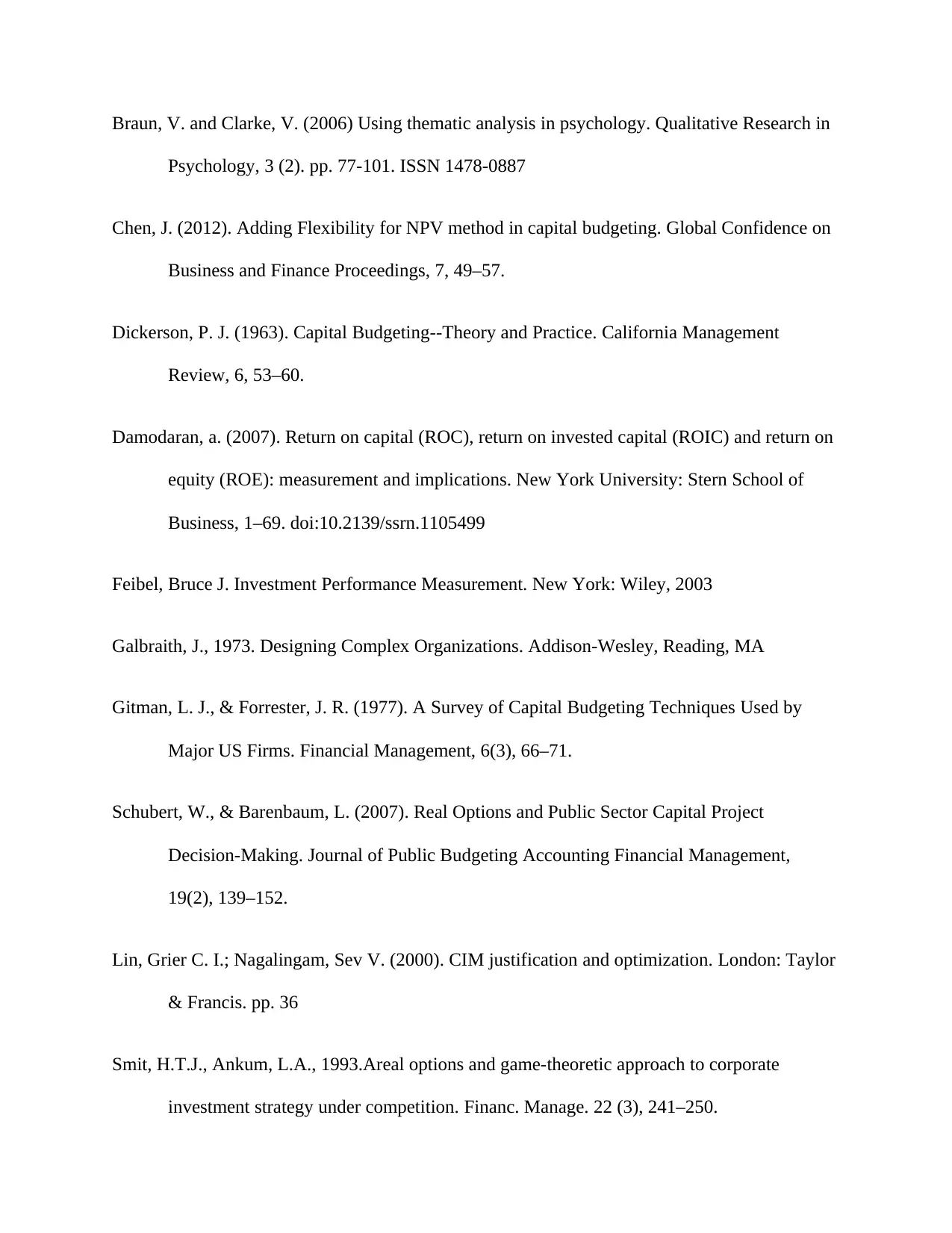
Braun, V. and Clarke, V. (2006) Using thematic analysis in psychology. Qualitative Research in
Psychology, 3 (2). pp. 77-101. ISSN 1478-0887
Chen, J. (2012). Adding Flexibility for NPV method in capital budgeting. Global Confidence on
Business and Finance Proceedings, 7, 49–57.
Dickerson, P. J. (1963). Capital Budgeting--Theory and Practice. California Management
Review, 6, 53–60.
Damodaran, a. (2007). Return on capital (ROC), return on invested capital (ROIC) and return on
equity (ROE): measurement and implications. New York University: Stern School of
Business, 1–69. doi:10.2139/ssrn.1105499
Feibel, Bruce J. Investment Performance Measurement. New York: Wiley, 2003
Galbraith, J., 1973. Designing Complex Organizations. Addison-Wesley, Reading, MA
Gitman, L. J., & Forrester, J. R. (1977). A Survey of Capital Budgeting Techniques Used by
Major US Firms. Financial Management, 6(3), 66–71.
Schubert, W., & Barenbaum, L. (2007). Real Options and Public Sector Capital Project
Decision-Making. Journal of Public Budgeting Accounting Financial Management,
19(2), 139–152.
Lin, Grier C. I.; Nagalingam, Sev V. (2000). CIM justification and optimization. London: Taylor
& Francis. pp. 36
Smit, H.T.J., Ankum, L.A., 1993.Areal options and game-theoretic approach to corporate
investment strategy under competition. Financ. Manage. 22 (3), 241–250.
Psychology, 3 (2). pp. 77-101. ISSN 1478-0887
Chen, J. (2012). Adding Flexibility for NPV method in capital budgeting. Global Confidence on
Business and Finance Proceedings, 7, 49–57.
Dickerson, P. J. (1963). Capital Budgeting--Theory and Practice. California Management
Review, 6, 53–60.
Damodaran, a. (2007). Return on capital (ROC), return on invested capital (ROIC) and return on
equity (ROE): measurement and implications. New York University: Stern School of
Business, 1–69. doi:10.2139/ssrn.1105499
Feibel, Bruce J. Investment Performance Measurement. New York: Wiley, 2003
Galbraith, J., 1973. Designing Complex Organizations. Addison-Wesley, Reading, MA
Gitman, L. J., & Forrester, J. R. (1977). A Survey of Capital Budgeting Techniques Used by
Major US Firms. Financial Management, 6(3), 66–71.
Schubert, W., & Barenbaum, L. (2007). Real Options and Public Sector Capital Project
Decision-Making. Journal of Public Budgeting Accounting Financial Management,
19(2), 139–152.
Lin, Grier C. I.; Nagalingam, Sev V. (2000). CIM justification and optimization. London: Taylor
& Francis. pp. 36
Smit, H.T.J., Ankum, L.A., 1993.Areal options and game-theoretic approach to corporate
investment strategy under competition. Financ. Manage. 22 (3), 241–250.
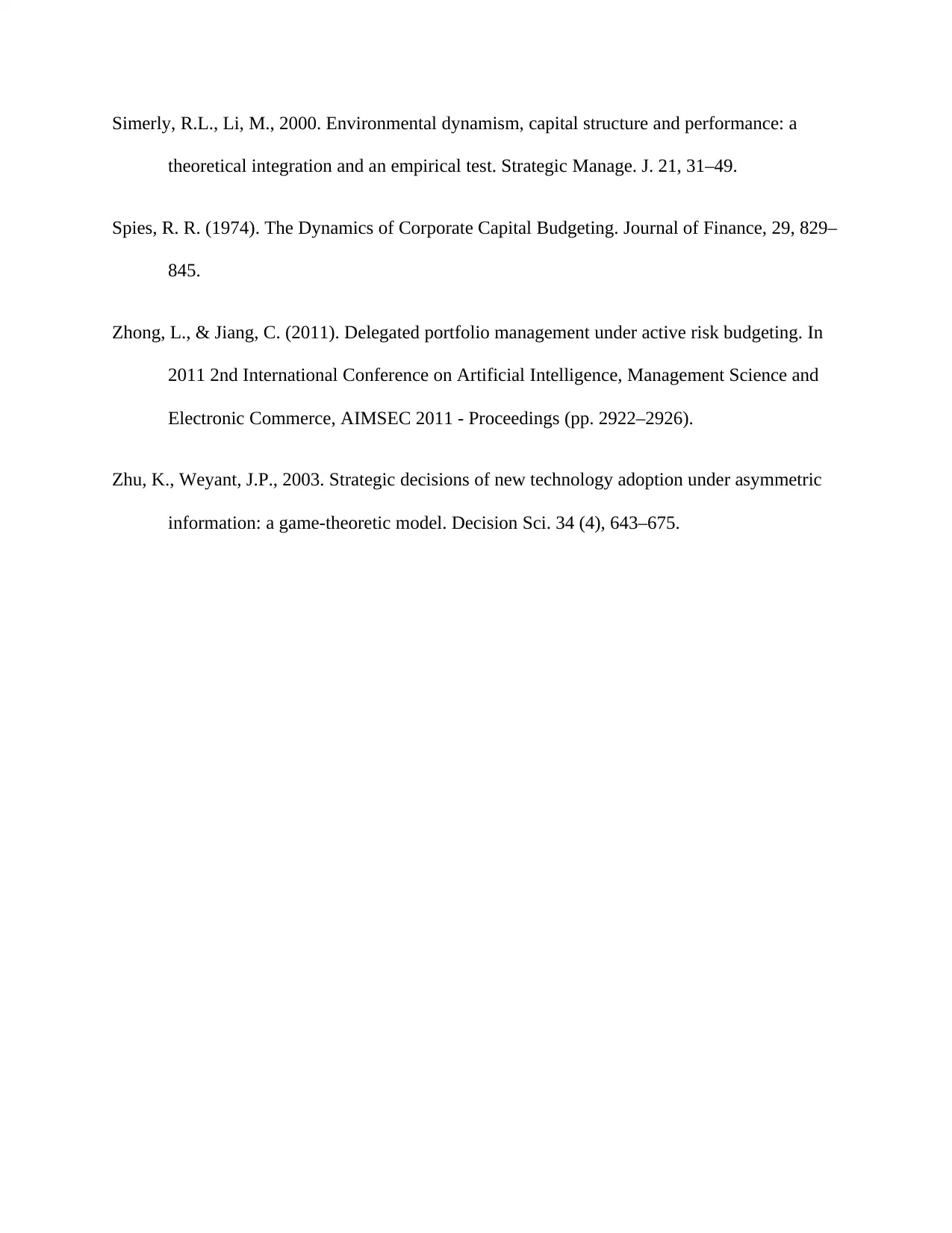
Simerly, R.L., Li, M., 2000. Environmental dynamism, capital structure and performance: a
theoretical integration and an empirical test. Strategic Manage. J. 21, 31–49.
Spies, R. R. (1974). The Dynamics of Corporate Capital Budgeting. Journal of Finance, 29, 829–
845.
Zhong, L., & Jiang, C. (2011). Delegated portfolio management under active risk budgeting. In
2011 2nd International Conference on Artificial Intelligence, Management Science and
Electronic Commerce, AIMSEC 2011 - Proceedings (pp. 2922–2926).
Zhu, K., Weyant, J.P., 2003. Strategic decisions of new technology adoption under asymmetric
information: a game-theoretic model. Decision Sci. 34 (4), 643–675.
theoretical integration and an empirical test. Strategic Manage. J. 21, 31–49.
Spies, R. R. (1974). The Dynamics of Corporate Capital Budgeting. Journal of Finance, 29, 829–
845.
Zhong, L., & Jiang, C. (2011). Delegated portfolio management under active risk budgeting. In
2011 2nd International Conference on Artificial Intelligence, Management Science and
Electronic Commerce, AIMSEC 2011 - Proceedings (pp. 2922–2926).
Zhu, K., Weyant, J.P., 2003. Strategic decisions of new technology adoption under asymmetric
information: a game-theoretic model. Decision Sci. 34 (4), 643–675.
⊘ This is a preview!⊘
Do you want full access?
Subscribe today to unlock all pages.

Trusted by 1+ million students worldwide
1 out of 13
Your All-in-One AI-Powered Toolkit for Academic Success.
+13062052269
info@desklib.com
Available 24*7 on WhatsApp / Email
![[object Object]](/_next/static/media/star-bottom.7253800d.svg)
Unlock your academic potential
Copyright © 2020–2025 A2Z Services. All Rights Reserved. Developed and managed by ZUCOL.
